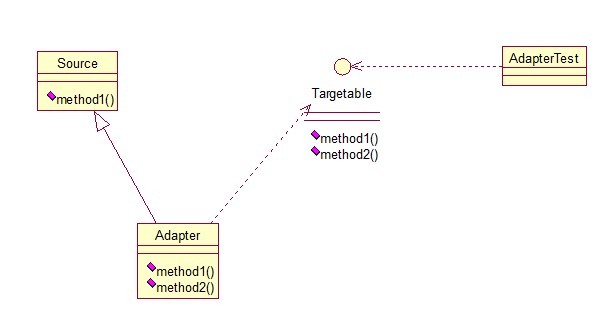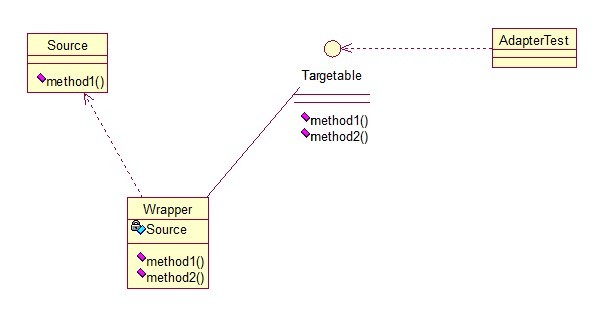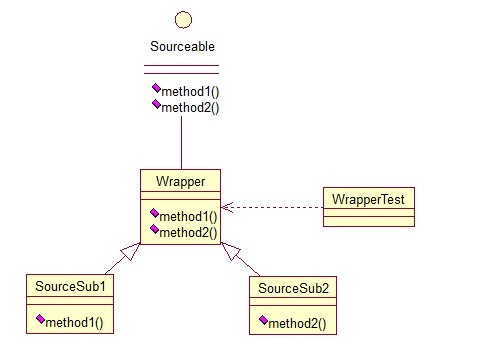适配器模式将某个类的接口转换成客户端期望的另一个接口表示,目的是消除由于接口不匹配所造成的类的兼容性问题。主要分为三类:类的适配器模式、对象的适配器模式、接口的适配器模式。首先,我们来看看类的适配器模式,先看类图:

核心思想就是:有一个Source类,拥有一个方法,待适配,目标接口时Targetable,通过Adapter类,将Source的功能扩展到Targetable里,看代码:
public class Source { public void method1() { System.out.println("this is original method!"); } }
public interface Targetable { /* 与原类中的方法相同 */ public void method1(); /* 新类的方法 */ public void method2(); }
public class Adapter extends Source implements Targetable { @Override public void method2() { System.out.println("this is the targetable method!"); } }
Adapter类继承Source类,实现Targetable接口,下面是测试类:
public class AdapterTest { public static void main(String[] args) { Targetable target = new Adapter(); target.method1(); target.method2(); } }
输出:
this is original method! this is the targetable method!
这样Targetable接口的实现类就具有了Source类的功能。
对象的适配器模式
基本思路和类的适配器模式相同,只是将Adapter类作修改,这次不继承Source类,而是持有Source类的实例,以达到解决兼容性的问题。看图:

只需要修改Adapter类的源码即可:
public class Wrapper implements Targetable { private Source source; public Wrapper(Source source){ super(); this.source = source; } @Override public void method2() { System.out.println("this is the targetable method!"); } @Override public void method1() { source.method1(); } }
测试类:
public class AdapterTest { public static void main(String[] args) { Source source = new Source(); Targetable target = new Wrapper(source); target.method1(); target.method2(); } }
输出与第一种一样,只是适配的方法不同而已。
接口的适配器模式
,接口的适配器是这样的:有时我们写的一个接口中有多个抽象方法,当我们写该接口的实现类时,必须实现该接口的所有方法,这明显有时比较浪费,因为并不是所有的方法都是我们需要的,有时只需要某一些,此处为了解决这个问题,我们引入了接口的适配器模式,借助于一个抽象类,该抽象类实现了该接口,实现了所有的方法,而我们不和原始的接口打交道,只和该抽象类取得联系,所以我们写一个类,继承该抽象类,重写我们需要的方法就行。看一下类图:

这个很好理解,在实际开发中,我们也常会遇到这种接口中定义了太多的方法,以致于有时我们在一些实现类中并不是都需要。看代码:
public interface Sourceable { public void method1(); public void method2(); }
抽象类Wrapper2:
public abstract class Wrapper2 implements Sourceable{ public void method1(){} public void method2(){} }
public class SourceSub1 extends Wrapper2 { public void method1(){ System.out.println("the sourceable interface's first Sub1!"); } }
public class SourceSub2 extends Wrapper2 { public void method2(){ System.out.println("the sourceable interface's second Sub2!"); } }
public class WrapperTest { public static void main(String[] args) { Sourceable source1 = new SourceSub1(); Sourceable source2 = new SourceSub2(); source1.method1(); source1.method2(); source2.method1(); source2.method2(); } }
测试输出:
the sourceable interface's first Sub1! the sourceable interface's second Sub2!
达到了我们的效果!
讲了这么多,总结一下三种适配器模式的应用场景:
类的适配器模式:当希望将一个类转换成满足另一个新接口的类时,可以使用类的适配器模式,创建一个新类,继承原有的类,实现新的接口即可。
对象的适配器模式:当希望将一个对象转换成满足另一个新接口的对象时,可以创建一个Wrapper类,持有原类的一个实例,在Wrapper类的方法中,调用实例的方法就行。
接口的适配器模式:当不希望实现一个接口中所有的方法时,可以创建一个抽象类Wrapper,实现所有方法,我们写别的类的时候,继承抽象类即可。